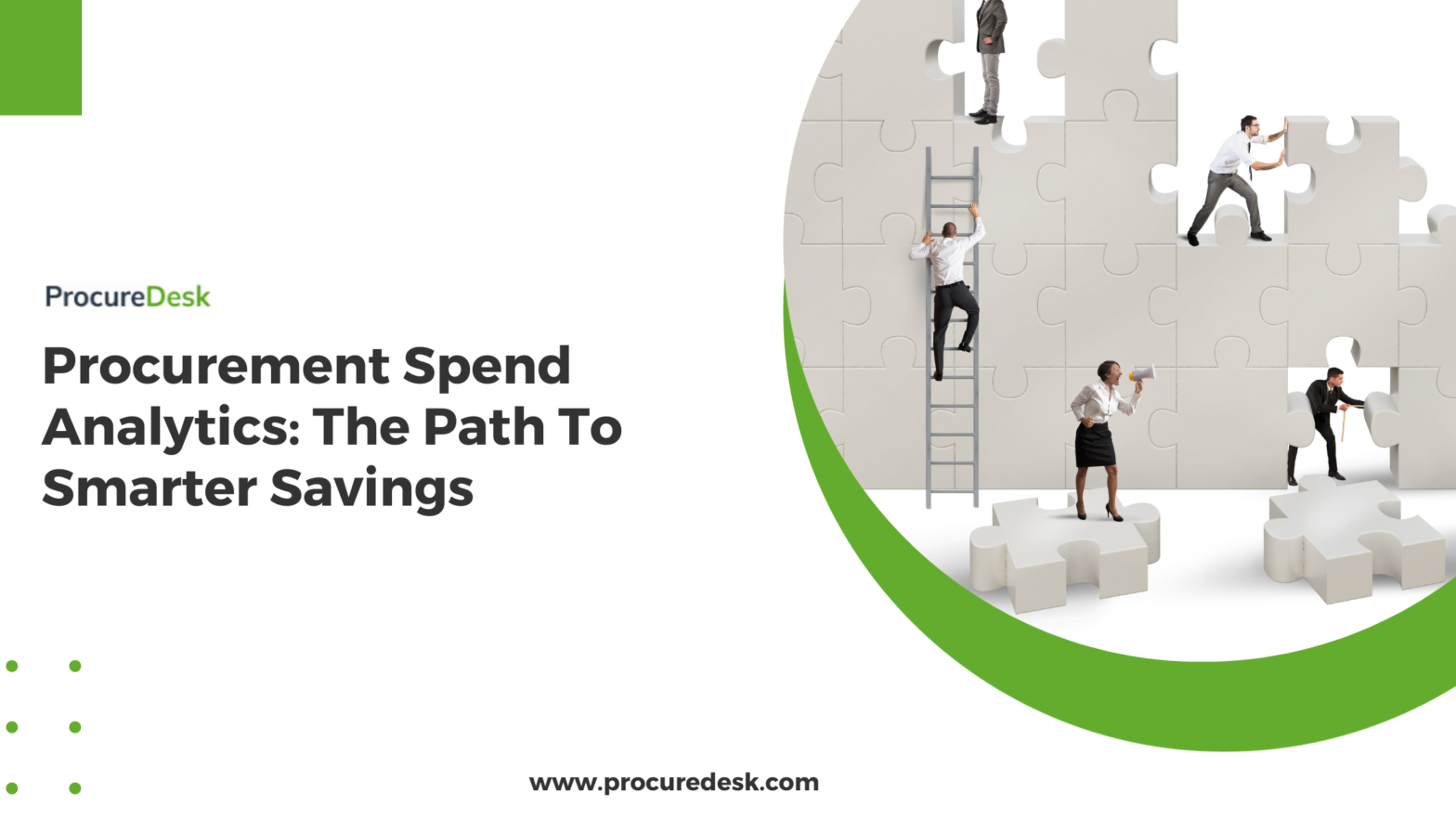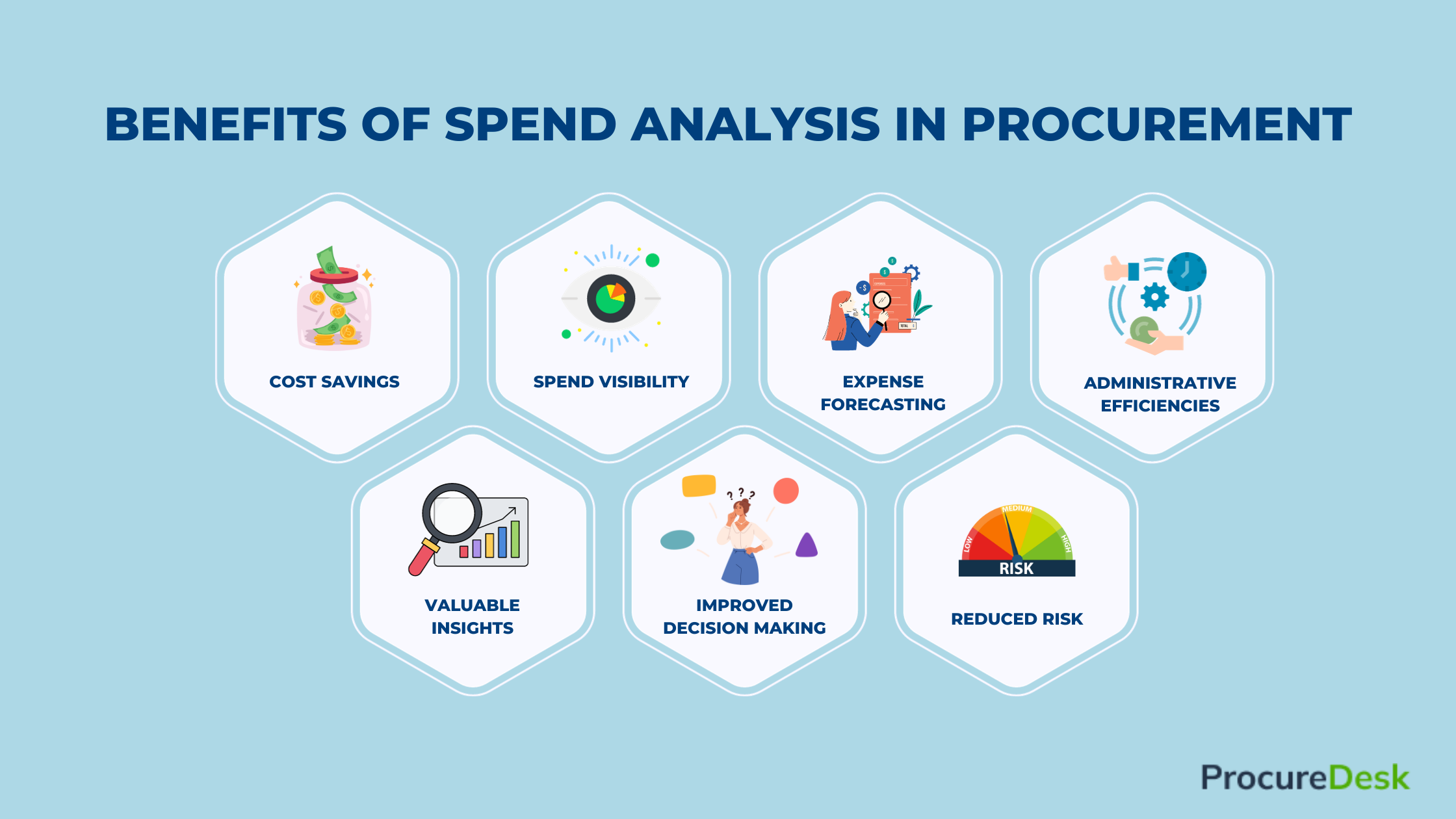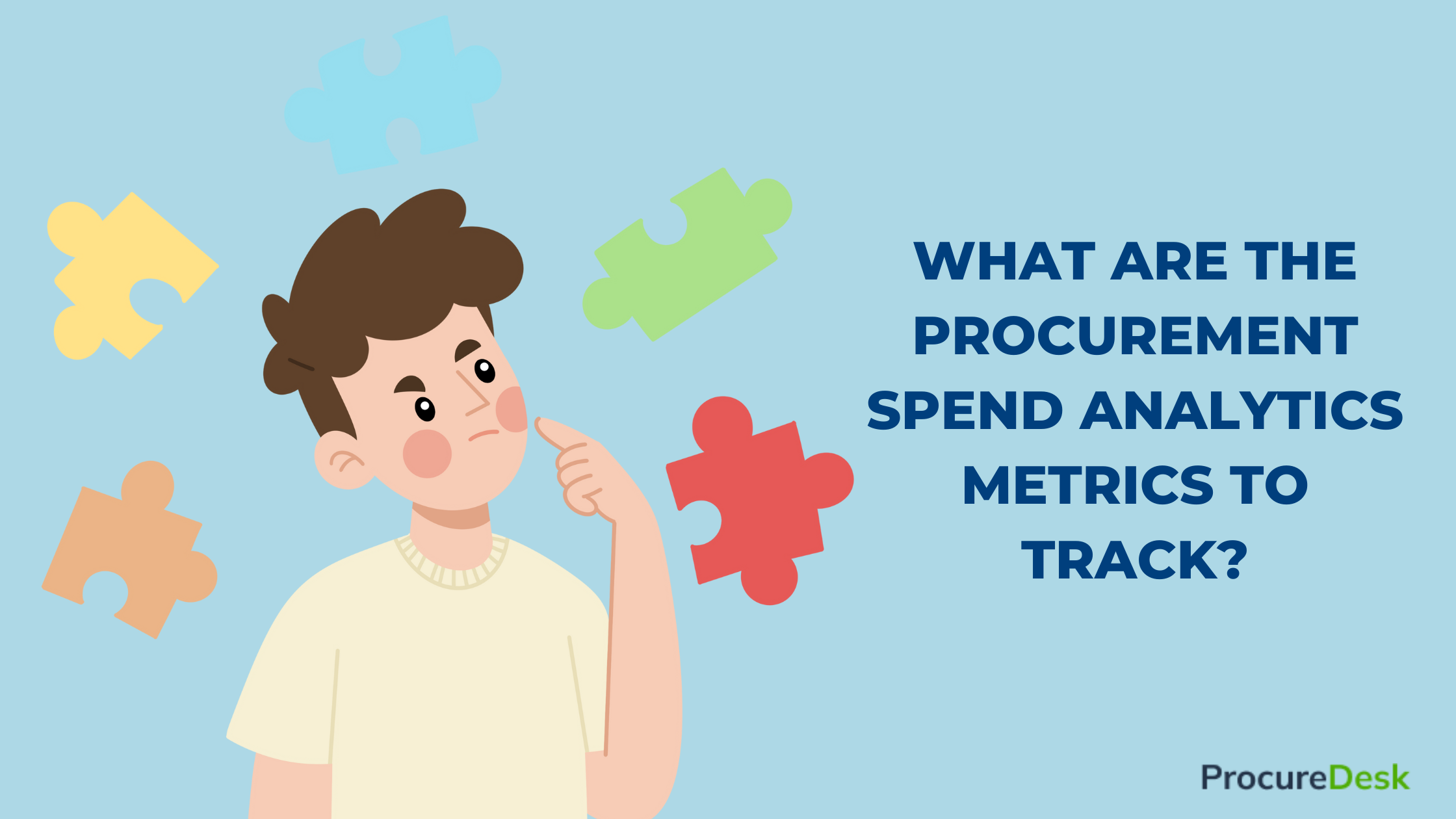The cost of uninformed business decisions can be harmful to your procurement process.
Imagine blindly navigating daily operational tasks for your suppliers, purchases, and contracts without data support.
The consequences – overspending, missed opportunities, and inefficiencies that affect your bottom line.
Thus, your business needs procurement spend analytics. This blog will dive into why procurement spend analytics is critical to your business and how it can transform your decision-making.
What Is Procurement Spend Analytics?
Procurement spend analytics collects, analyzes, and reports an organization’s procurement spending data. This helps your company gain insights into your spending patterns and key performance indicators (KPIs), which results in identifying cost-saving opportunities and more informed sourcing decisions.
Your company can use procurement spend analysis to answer a range of questions, such as:
- What are our top spending categories?
- Who are our top suppliers?
- Where are we spending the most money?
- Are we getting the best possible prices and terms?
- Are we compliant with our procurement policies?
- Are there any opportunities to consolidate our spending?
- Are there any areas where we can reduce our costs?
Why Is Procurement Spend Analytics Important?
Procurement spend analytics is vital in helping your organization achieve financial efficiency by providing valuable insights into your spending patterns, supplier performance, and potential savings opportunities.
Here are key reasons why procurement spend analytics is important in your company:
Actionable Insights
Your company’s procurement team can leverage your spending analytics to gain actionable insights into your procurement process.
By analyzing spending data, your organization can identify areas where cost reductions can be made, optimize supplier contracts, and uncover potential savings opportunities.
Supplier Relationships
Spend analytics can help you improve supplier relationships by evaluating supplier performance and identifying areas for improvement. By analyzing delivery times, quality, and pricing data, your organization can negotiate better contract terms and identify opportunities to consolidate your supplier base. Thus resulting in cost savings.
Process Improvements
Procurement spend analytics helps your organization identify process inefficiencies within your company processes. By understanding spending patterns, your organization can streamline your procurement process, eliminate maverick spending, and optimize purchasing decisions.
Strategic Decision-Making
Your procurement department can leverage spend analytics to make smarter decisions and optimize your procurement strategies. Real-time visibility into your spending data enables you to identify primary objectives and goals, evaluate preferred suppliers, and make informed sourcing, pricing, and inventory decisions.
Key Terms And Definitions In Procurement Spend Analytics
Diving into procurement spend analytics requires you and your procurement professionals to understand the key terms and definitions used in this process.
Here are some of the key terms and definitions in procurement spend analytics for you to take note of:
Spend data: Spend data refers to your company’s expenditures (goods and services) you purchase from suppliers. This may come from various sources like enterprise resource planning (ERP) systems, purchase order systems, and supplier invoices.
Spend data management: This includes tasks such as data extraction, data cleansing, and data enrichment. Spend data management is essential for effective spend analytics in your business.
Spend analytics: This refers to collecting, cleansing, classifying, and analyzing spending data. This can be done through your chosen dedicated spend analytics solution software or one-off spend cubes. Your company can use spend analytics to identify trends, patterns, and anomalies in spending data and even gain insights into your organization’s procurement spending.
Spend analysis: Through spend analysis, you can analyze your spending data, decrease your costs, increase your efficiency, and improve your supplier relationship. You can use spend analysis to identify opportunities to consolidate your spending, negotiate better prices, and reduce your maverick spending.
Here are other key terms and definitions related to procurement spend analytics:
- Category: A group of related goods or services with similar characteristics.
- Classification: The process of assigning spending data to categories.
- Maverick spend: Spending that your procurement department does not manage.
- Supplier concentration: The concentration of spend with a small number of suppliers.
- Financial risk: The risk of financial loss associated with a supplier.
What Are The 4 Stages In Procurement Spend Analytics?
Procurement spend analytics is critical to your strategic procurement management, systematically analyzing your organization’s spending patterns and expenditures.
Here are the four stages in procurement spend analytics to help you understand insights considered a source of truth into your spending data and identify cost-saving opportunities to enhance your overall procurement process:
Step 1: Data Collection
The first key step of procurement spend analytics is to collect real-time data from a relevant single source. This includes financial records, invoices, purchase orders, receipts, and supplier contracts. Collecting as much data as possible is important to get a complete picture of an organization’s spending.
Step 2: Data Cleansing
After collecting the data, it must be cleaned to ensure accuracy and completeness. This may involve removing duplicate data, correcting errors, and filling in missing data. Data cleansing is important for effective spend analytics, as inaccurate or incomplete data can lead to misleading results.
Step 3: Data Analysis
Once the data has been cleaned, it can be analyzed using various tools and techniques to make it easier to identify trends, patterns, and anomalies. This may include data visualization, statistical analysis, and machine learning.
Data analytics is the core of your spend analytics and how your insights are generated.
Step 4: Data Reporting
The final state of the spend analysis process is reporting the results to your company’s appropriate stakeholders. You can do this through real-time dashboards, reports, and presentations.
A priority for procurement teams is to communicate the analysis results clearly and concisely so that your stakeholders can easily understand the collected insights and take action accordingly.
Overall, spend analytics gives stakeholders the insights they need to make informed decisions about the procurement process.
How Can ProcureDesk Help With Procurement Spend Analytics?
With ProcureDesk’s user-friendly dashboard and robust reporting features, you’ll clearly understand your company’s financial outlays and cash movement, a crucial component of efficient financial administration.
For instance, you can swiftly identify the specifics of your procurements and their sources while also identifying the highest spenders within your company.
ProcureDesk grants access to more than 30 comprehensive reports with detailed transaction summaries.
This automation software simplifies the monitoring of invoices even when receipts are absent, making the follow-up process smoother for your Accounts Payable team and guaranteeing that your stakeholders confirm the receipt of products.
Here is a screenshot of a report coming from ProcureDesk’s dashboard:
Benefits Of Spend Analysis In Procurement
As mentioned earlier, spend analysis is a crucial procurement process that benefits your organization.
By analyzing your spending patterns and data, your procurement teams gain actionable insights that can impact your strategies and operations.
Here are some of the benefits of procurement spend analytics:
Cost Savings
One of the key benefits of conducting a spending analysis is the opportunities for savings it offers. Through deep analysis of spending patterns, your organization can identify opportunities for consolidating suppliers, negotiating better contract terms, and leveraging your purchasing power.
This reduces cost and enables procurement professionals to make smarter budget decisions.
Spend Visibility
Spend analysis gives your company full visibility into spending across your business units and departments (tail spending, external spend, etc. Thus enhancing your procurement efficiency. This enables your organization to view your supplier base and identify preferred suppliers comprehensively.
By streamlining your procurement process and reducing maverick spending, your organization can maximize the value you receive from your supplier relationships.
Expense Forecasting
Spend analysis also supports expense forecasting and helps your organization identify potential savings opportunities. By analyzing historical spending data, your organization gains deeper insights into your spending habits and can make more accurate predictions regarding future expenses. This allows them more effective budget planning and allocation.
Administrative Efficiencies
Your organization can automate data consolidation and cleansing by utilizing analytics tools and solutions, eliminating manual and time-consuming processes. This saves time and resources and ensures accuracy and reliability in the analysis.
Valuable Insights
Spend analysis plays a vital role in procurement by providing your organization with meaningful insights that can drive cost savings, improve key supplier relationships, enhance procurement efficiency, enable expense forecasting, and streamline administrative processes.
Your company needs to implement an effective spend analysis solution so your team can successfully optimize your operations and achieve strategic objectives.
Improved Decision Making
Procurement spend analytics provides your company’s procurement professionals with the data and insights to make more informed decisions about sourcing, negotiating, and managing contracts.
Reduced Risk
Procurement spend analytics can help your organization identify and mitigate risks associated with your supply chain, such as supplier concentration and financial risks.
What Are The Procurement Spend Analytics Metrics To Track
Several procurement spend analytics metrics can be tracked to gain insights into your company’s spending patterns and identify opportunities for cost savings and other improvements.
Some of the most important metrics you must track include:
- Spend under management (SUM): SUM is your procurement department’s total spending. SUM is a good measure of the procurement department’s influence and maturity.
- Spend by category: This metric tracks spending by category, such as raw materials, MRO, and services. This information can be used to identify the categories where your organization is spending the most money and to target cost-saving initiatives.
- Spend by supplier: This metric tracks spending by supplier. You can use this to identify the organization’s top suppliers and to negotiate better prices and terms.
- Price variance: This metric tracks the difference between the actual price paid for a good or service and the expected price. Several factors, such as negotiation failures, supplier price increases, and changes in specifications, can cause price variance.
- Maverick spend: Maverick spending can lead to higher prices, lower quality goods and services, and increased risk. Although, your procurement does not manage this metric department.
- Supplier performance: This metric tracks the performance of your suppliers, such as delivery on time and in full, quality, and cost. Tracking supplier performance can help you to identify and mitigate risks.
In addition to these general metrics, several other specific metrics can be tracked depending on your organization’s needs. For example, if your organization is focused on sustainability, you may want to track your spending on sustainable goods and services. On the other hand, if your organization is focused on risk management, you may want to track your spending on high-risk suppliers.
By tracking the right metrics, your procurement professionals can gain valuable insights into your organization’s spending patterns and identify cost savings, process improvement, and risk reduction opportunities.
Best Practices In Procurement Spend Analytics
To make the most out of your procurement spend analytics, you must optimize this procurement process with some of these.
- Conduct spending analysis frequently. Spend analysis should be conducted regularly, such as quarterly or annually. This will help you to identify trends and patterns in spending data and to ensure that your organization is taking advantage of all opportunities for cost savings and process improvement.
- Review existing spend management. Before conducting a spending analysis, reviewing your organization’s existing spending management processes and procedures is important. This will help you to identify areas where there is room for improvement.
- Develop a classification strategy. Before collecting and analyzing spending data, it is important to develop a classification strategy. This will help you ensure that your data is collected consistently and categorized in a useful way for analysis.
- Collect spending data from all internal and external sources. Spend data can come from various sources, such as ERP systems, purchase order systems, supplier invoices, and travel and expense reports. Collecting spending data from all relevant sources is important to understand the organization’s spending.
- Keep track of your vendors’ efficiency. Spend analytics can be used to track the performance of your suppliers, such as delivery on time and in full, quality, and cost. You can use this information to identify and mitigate risks and improve vendor relationships.
- Automate your procurement process. Automating your procurement process can help you reduce the cost of processing transactions and free up procurement professionals to focus on more strategic tasks. Spend analytics can be used to identify opportunities to automate the procurement process.
In addition to these best practices, using the right tools and technologies for spending analytics is also important. There are several commercial and open-source analytics software available. Your organization should choose a digital solution appropriate for your size, budget, and needs.
Why You Should Use Procurement Spend Analytics Software?
A procurement spend analytics software is an important tool for your organization to optimize your procurement process and drive cost savings. By utilizing a procurement software, your company can maximize the value of your spending data and gain meaningful insights to help you make informed decisions.
Here are some of the key advantages of using a procurement spend analytics software:
Analytics Dashboard
These real-time dashboards offer a centralized view of all procurement activities, allowing your teams to analyze spending patterns, identify trends, and track performance indicators.
With this holistic view, your organization can better understand your spending habits and make data-driven decisions to optimize its procurement process.
Identify Savings And Compliance Opportunities
Your organization can uncover cost-saving opportunities by analyzing spending data, such as consolidating suppliers, renegotiating contracts, or optimizing purchasing volumes.
Additionally, an accounts payable software tool that features an analytics dashboard enables your organization to ensure compliance with contract terms and policies, mitigate the risk of maverick spending, and improve supplier relationships.
Risk Reduction
Another advantage of using procurement spend analytics software is its risk reduction. This software provides real-time visibility into the supply chain, enabling your organization to identify potential risks and proactively take necessary actions to prevent supply chain failures.
By monitoring supplier performance and analyzing data, your organization can mitigate supply chain risks, ensure timely delivery of goods and services, and maintain business continuity.
If you want to explore how ProcureDesk’s dashboard can help you analyze your procurement’s insights, we have a team of experts who can walk you through our tool. See it in action today!
FAQs
How Can Spend Analytics Support Procurement?
Spend analytics can support procurement in several ways, including:
- Identifying cost savings opportunities: Spend analytics can help procurement identify areas where the organization overpays for goods and services. For example, spend analytics can identify duplicate spending, unused contracts, and suppliers charging higher prices than their competitors.
- Improving supplier management: Spend analytics can help you get a better supply management system. For example, spend analytics can identify which suppliers are the most important to the organization, which are performing well, and which could be improved.
- Optimizing the procurement process: Spend analytics can help procurement optimize its processes. For example, spend analytics can identify bottlenecks in the procurement process and areas where the process can be streamlined.
- Making better sourcing decisions: Spend analytics can help procurement make better decisions. For example, spend analytics can identify which suppliers are most likely to meet the organization’s needs and which suppliers are offering the best prices.
What Happens Under Spend Analytics?
Spend analytics typically involves the following steps:
- Data collection: The first step in spend analytics is to collect data on the organization’s procurement spending from an accurate source. This data can be collected from various sources, such as accounting systems, ERP systems, and procurement software.
- Data cleansing: Once the data from the accurate source has been collected, it must be cleaned and normalized. This involves removing any errors or inconsistencies in the data and ensuring that all of the data is in a consistent format.
- Data analysis: Once the data from the accurate source has been cleaned, it can be analyzed to identify trends and patterns. This analysis can be performed using various tools and techniques, such as statistical analysis and data visualization.
- Reporting: The final step in spending analytics is generating reports and communicating the analysis findings to stakeholders. These reports can be used to inform decision-making and to identify areas for improvement.
What Is The Modern Spend Cube?
The modern “Spend Cube” is a data modeling framework for organizing and analyzing procurement spending data. The spend cube is a three-dimensional model that organizes data by supplier, category, and period. This allows procurement professionals to analyze their spend data from multiple perspectives easily.
What Are The Sources Of Procurement Spend Analytics Data?
Here are some of the sources you can use for procurement spend data analytics:
- Accounting systems
- Enterprise resource planning (ERP) systems
- Expense management systems
- Procurement software
- Payroll software
- Bank and credit card accounts
- Industry benchmarking information
How Do You Do A Spend Analysis In Excel?
To do a spend analysis in Excel, you can follow these steps:
- Collect your spending data from accurate sources.
- Clean and normalize the data.
- Create a pivot table to analyze the data.
- Use charts and graphs to visualize the data.
- Analyze the data to identify trends and patterns.
- Generate reports to communicate the findings of your analysis to stakeholders.
What Is The Difference Between Spend Analytics And Spend Analysis?
Spend analytics is a more comprehensive and sophisticated approach to analyzing procurement spend data than spend analysis. Spend analytics typically involves using various tools and techniques to analyze the data from accurate sources from multiple perspectives. Spend analysis is typically more focused on identifying specific cost savings opportunities.
In general, spend analytics is more strategic for analyzing procurement spend data, while spend analysis is more tactical.
The Bottomline
Procurement spend analytics is a powerful analysis tool to help your organization save money, improve efficiency, reduce risk, and make better decisions. It’s a critical tool for modern business units like yours to make data-driven decisions in their procurement operations. We highly recommend that you use an analysis software to ensure you get the data you need.
By implementing procurement spend analytics, your organization can better understand your procurement spending, achieve your primary goals, and identify opportunities to improve your bottom-line value and lead to better supply management.

















